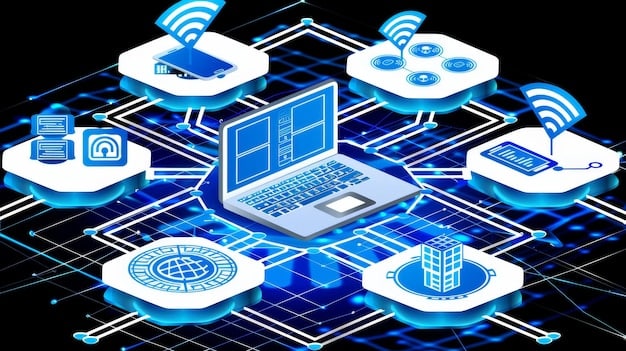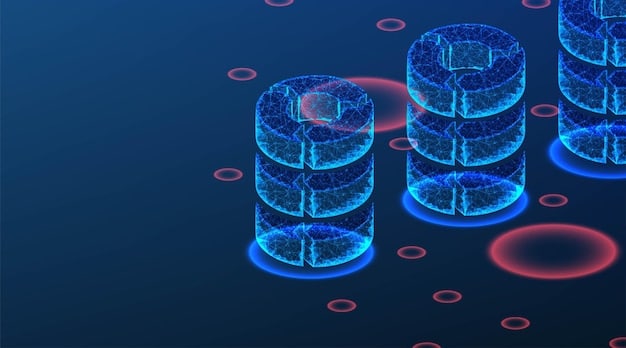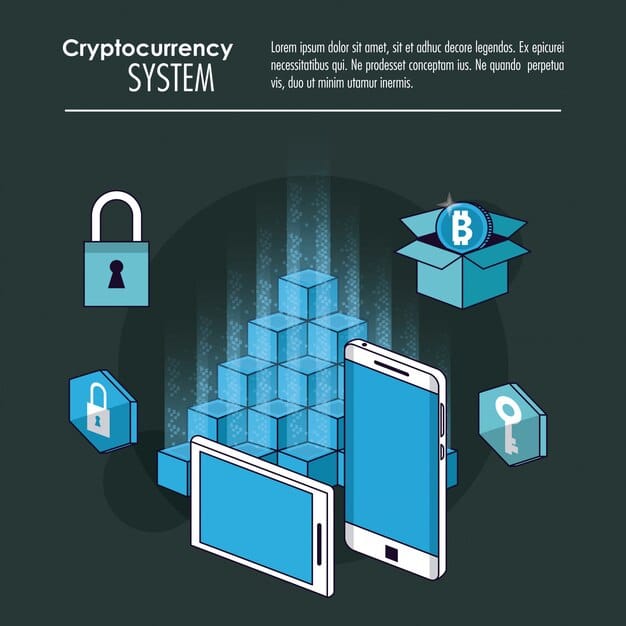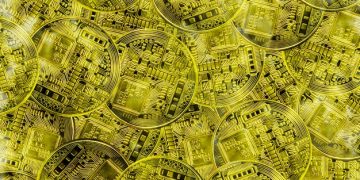Blockchain and IoT Security: Protecting US Data Streams

Blockchain and the Internet of Things (IoT) integration offers enhanced security for IoT devices and data streams in the US, leveraging blockchain’s decentralized and immutable nature to address vulnerabilities in traditional IoT systems.
The convergence of Blockchain and the Internet of Things (IoT): Securing IoT Devices and Data Streams in the US, represents a transformative shift in how data is secured and managed. As the number of IoT devices proliferates, the need for robust security measures becomes increasingly critical. This article explores the synergy between these two groundbreaking technologies and their application within the United States.
Understanding the Convergence of Blockchain and IoT
In today’s interconnected world, the Internet of Things (IoT) has become an integral part of our daily lives, connecting devices from smart home appliances to industrial sensors. However, this interconnectedness brings about significant security challenges. Traditional IoT systems are often plagued by vulnerabilities, making them susceptible to cyberattacks. Blockchain technology offers a potential solution by providing a decentralized and immutable platform for securing IoT devices and data streams.
The convergence of these technologies presents a unique opportunity to enhance the security, transparency, and efficiency of IoT ecosystems in the United States. By integrating blockchain, we can address critical security concerns and build more resilient and trustworthy IoT networks.
Key Benefits of Blockchain in IoT
Blockchain’s unique properties enhance IoT security, reliability, and efficiency.
- Enhanced Security: Blockchain offers a secure and tamper-proof environment for IoT data, protecting against unauthorized access and manipulation.
- Improved Transparency: Every transaction and interaction is recorded on the blockchain, creating a transparent and auditable trail.
- Increased Efficiency: Automation through smart contracts streamlines processes, reducing the need for manual intervention and improving overall efficiency.
- Decentralization: Eliminating central points of failure makes systems more resistant to attacks.
In conclusion, integrating blockchain with IoT offers enhanced security, transparency, and efficiency. This convergence promises to transform industries and address critical security concerns in interconnected networks.

Addressing IoT Security Challenges with Blockchain
Traditional IoT systems often rely on centralized architectures, which can be vulnerable to single points of failure. In contrast, blockchain offers a decentralized solution, distributing data across multiple nodes and making it more resistant to tampering. This is particularly important in the US, where data privacy regulations and cybersecurity threats are constantly evolving.
Furthermore, blockchain can enhance the authentication and authorization processes for IoT devices. By using cryptographic keys and digital signatures, blockchain can ensure that only authorized devices can access and transmit data, reducing the risk of unauthorized access and data breaches.
Specific Security Vulnerabilities Addressed
Blockchain directly mitigates critical IoT security risks.
- Data Tampering: Blockchain’s immutability prevents alteration of recorded data.
- Device Authentication: Ensures only verified devices connect to the network.
- Denial-of-Service Attacks: Decentralization reduces the impact of targeted attacks.
- Data Privacy: Enhanced encryption and access controls protect sensitive information.
In conclusion, blockchain technology presents a robust solution to address the inherent security vulnerabilities of traditional IoT systems, particularly in the context of data privacy and cybersecurity threats prevalent in the US. By decentralizing data and enhancing authentication processes, the integration of blockchain and IoT creates more secure and trustworthy networks.
Real-World Applications of Blockchain in IoT in the US
The integration of blockchain and IoT is not just a theoretical concept; it is already being applied in various industries across the United States. From supply chain management to healthcare, the synergy between these technologies is transforming how data is managed and secured.
In supply chain management, blockchain can provide end-to-end visibility and traceability, ensuring the authenticity and integrity of products as they move through the supply chain. This can help combat counterfeiting, reduce fraud, and improve overall efficiency. In healthcare, blockchain can secure patient data, facilitate secure data sharing among healthcare providers, and streamline administrative processes.
Examples of US-Based Implementations
US-based companies pioneer blockchain IoT solutions.
* **Supply Chain Tracking:** Pharmaceutical companies use blockchain to track drugs, ensuring authenticity and preventing counterfeiting.
* **Smart Agriculture:** Farmers deploy IoT sensors to monitor crops, using blockchain to secure environmental data and optimize resource use.
* **Energy Management:** Utilities use blockchain to manage energy distribution from smart grids, securing data from IoT-enabled meters.
In conclusion, the real-world applications of blockchain in IoT are expanding, with industries across the US leveraging these technologies to improve security, transparency, and efficiency. From supply chain management to healthcare, the potential for innovation is vast.

Challenges and Considerations for Implementation
While the potential benefits of integrating blockchain and IoT are significant, there are also several challenges and considerations that organizations need to address. Scalability, interoperability, and regulatory compliance are among the key concerns that must be carefully managed to ensure successful implementation.
Scalability is a critical issue, as blockchain networks may struggle to handle the massive amounts of data generated by IoT devices. Interoperability is also important, as different blockchain platforms may not be easily compatible with each other. Regulatory compliance is an ongoing challenge, as the legal and regulatory landscape for blockchain and IoT continues to evolve.
Addressing the Implementation Hurdles
Overcoming challenges requires strategic planning and adaptable solutions.
- Scalability Solutions: Implementing layer-2 solutions and sharding techniques to handle increased data loads.
- Interoperability Standards: Adopting common protocols for seamless data exchange between different blockchain networks.
- Regulatory Navigation: Staying informed about evolving laws through legal counsel and industry collaboration.
To conclude, despite significant benefits, implementing blockchain solutions in IoT networks requires careful management of scalability, interoperability, and regulatory compliance challenges. By addressing these concerns proactively, organizations can pave the way for successful integration of these transformative technologies.
The Role of Smart Contracts in Securing IoT Data Streams
Smart contracts, self-executing contracts written in code and stored on the blockchain, play a crucial role in securing IoT data streams. They automate and enforce predefined rules and conditions, ensuring that data is processed and shared in a secure and transparent manner. In the US, where data privacy is a major concern, smart contracts can help organizations comply with regulations such as the California Consumer Privacy Act (CCPA).
For example, smart contracts can be used to control access to IoT data, ensuring that only authorized parties can access sensitive information. They can also be used to automate data validation and verification processes, reducing the risk of data manipulation and fraud.
How Smart Contracts Enhance Data Security
Smart contracts introduce automation and security in IoT ecosystems.
- Automated Access Control: Smart contracts automatically enforce access permissions, preventing unauthorized data access.
- Data Integrity Verification: They validate data authenticity, minimizing the risk of data manipulation.
- Secure Data Sharing: Facilitating secure and transparent data exchange between IoT devices and systems.
In essence, smart contracts enhance data security by automating access control, ensuring data integrity, and facilitating safe data sharing, which are critical components in the integration of blockchain and IoT, particularly in the U.S.
Future Trends and Developments in Blockchain IoT
The future of blockchain IoT holds tremendous promise, with ongoing developments in areas such as decentralized identity management, edge computing, and artificial intelligence. As these technologies continue to evolve, we can expect to see even more innovative applications of blockchain in IoT in the United States.
Decentralized identity management can help address privacy concerns by giving individuals greater control over their personal data. Edge computing can bring data processing closer to the source, reducing latency and improving overall efficiency. Artificial intelligence can enhance the capabilities of blockchain IoT systems, enabling them to learn and adapt to changing conditions.
Emerging Trends in the US Market
US market trends are shaping the future of blockchain IoT.
* **Enhanced Data Privacy:** With growing concerns about data breaches, greater focus on privacy-preserving technologies.
* **5G Integration:** Leveraging faster connectivity to enable more complex IoT applications.
* **AI-Driven Security:** Artificial intelligence algorithms improving threat detection and response.
In conclusion, the U.S. market for blockchain and IoT is heading toward a future characterized by enhanced data privacy, 5G integration, and AI-driven security. As these trends evolve, they will pave the way for new and innovative implementations of blockchain in IoT.
| Key Aspect | Brief Description |
|---|---|
| 🛡️ Enhanced Security | Blockchain addresses IoT vulnerabilities, ensuring data integrity and device authentication. |
| 🔗 Transparency | Blockchain provides a transparent and complete record of every IoT interaction. |
| ⚙️ Smart Contracts | Automate access control and ensure secure data exchange. |
| 📈 Future Trends | Ongoing developments in decentralized identity, edge computing, and AI enhance capabilities. |
FAQ
▼
IoT systems face challenges such as data tampering, device authentication issues, and denial-of-service attacks, making them vulnerable to breaches and manipulation.
▼
Blockchain enhances security by providing a tamper-proof and transparent environment for IoT data. It also secures communications through decentralized, immutable ledgers.
▼
Smart contracts automate and enforce security protocols such as access control and data integrity verification, facilitating secure data sharing between devices and systems.
▼
Challenges include scalability issues due to large data volumes, interoperability limitations between platforms, and navigating the evolving regulatory landscape in the US.
▼
Future trends include decentralized identity management for data privacy, edge computing for low-latency data processing, and AI to enhance threat detection and response.
Conclusion
The integration of Blockchain and the Internet of Things (IoT) presents a promising pathway to enhance the security and efficiency of data management in the US. By leveraging the strengths of both technologies, organizations can address critical security concerns, improve transparency, and unlock new opportunities for innovation across various industries.





